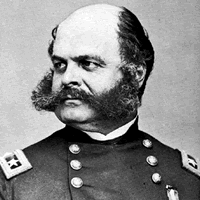
|
|
VITAL STATISTICS
|
BORN: 1824 in Liberty, IN.
DIED: 1881 in Bristol, RI.
CAMPAIGN: He participated in all of the major battles in the east.
He was Commander of the Potomac, briefly in 1862, before being relieved
after the failure at Fredericksburg. He continued to serve until the
failure of the mine explosion at Fredericksburg.
HIGHEST RANK ACHIEVED: Major General.
|
|
BIOGRAPHY
|
| Ambrose Everett Burnside was born on May 23, 1824, in Liberty, Indiana. He was the son of a South Carolina slavewoner who had moved his family to Indiana after he freed his slaves. At the age of 19, young Burnside was appointed to the US Military Academy at West Point. After graduating in 1847; he was brevetted a 2d lieutenant, 2d Artillery. He served on garrison duty during the Mexican War, then was wounded in a struggle with Apaches while he was stationed along the southwestern frontier. Burnside got along well with others, and was known as an easy-going officer with a love of gambling. In 1853, he resigned from the US Army and opened a factory in Rhode Island to manufacture rifles he had designed. When a government contract fell through, Burnside's factory was forced into bankruptcy. His creditors took over the patent for the Burnside carbine rifle, and produced more than 55,000 rifles for the US Army. Burnside began working for his friend, George McClellan, who was chief engineer of the Illinois Central Railroad. After being jilted at the altar by his Kentucky fiancée, he was appointed major general of the Rhode Island Militia. When the Civil War began, he joined the US Army again. He served as a colonel in the 1st Rhode Island Volunteers, a 90-day regiment which he helped organize. The 1st Rhode Island Volunteers were one of the first of the 90-day regiments to arrive in Washington when it was threatened by Confederate attack. At the First Battle of Bull Run, Burnside commanded a brigade, and was commissioned brigadier general on August 6, 1861, by Lincoln himself. In 1862, his troops destroyed a small Confederate fleet in Albemarle and Pamlico Sounds. Within the next few months, he captured Roanoke Island (taking 2,600 prisoners and 32 guns), New Berne, Beaufort and Fort Macon. He was promoted to major general, for his capture of Fort Macon, on March 18, 1862. Under Maj. Gen. George B. McClellan, Burnside led the IX Corps and Maj. Gen. Joseph Hooker's I Corps. At the Battle of Antietam, Burnside was determined to cross a defended bridge over the Antietam Creek, later known as "Burnside Bridge." This delayed the troops' arrival on the field, and caused the Union to lose an opportunity to defeat the Confederates in a weak position. Burnside was a capable officer, but he lacked confidence in his abilities as a commander. Thus, when Lincoln twice offered to remove McClellan and give Burnside command of the Army of the Potomac, Burnside did not accept. Finally, in November of 1862, he accepted the position. He attacked Gen. Robert E. Lee's army at Fredericksburg, Virginia. Burnside's lack of resolution, however, led to his losing the battle, in addition to disappointing Lincoln and injuring the army's morale. In an attempt to make up for the defeat at Fredericksburg, Burnside decided to cross the Rappahannock River and attack the Confederates from behind. As the troops began moving, in January of 1863, it began raining heavily, with strong winds. By the end of the day, the march across the river was a muddy, disorganized mess, which was later called Burnside's "Mud March." He was removed from command, and placed in charge of the Department of the Ohio. There, he presided over the arrest and (military) trial of former Congressman Clement L. Vallandigham for sedition, as well as the arrests and trials of captured Confederate cavalryman John Hunt Morgan and some of his men. Burnside helped improve his tarnished reputation by defending Knoxville against Lt. Gen. James Longstreet's Confederate assault. In 1864, Burnside was placed in command of his former IX Corps, which he led at the Wilderness, Spotsylvania, North Anna, Totopotomoy and Bethesda Church. At Petersburg, however, Burnside failed to move quickly, so that his troops suffered heavy casualties at the Battle of the Crater. After this, he was relieved of command for handling troops improperly. He resigned his commission on April 15, 1865. After the Civil War, Burnside was elected governor of Rhode Island in 1866, 1867 and 1868; then returned to business affairs. He was elected to the US Senate in 1874, and served until his death on September 13, 1881, in Bristol, Rhode Island. |
|

